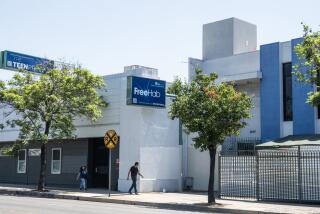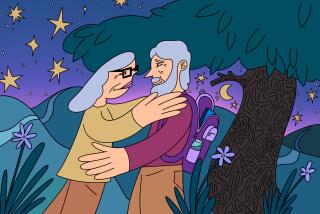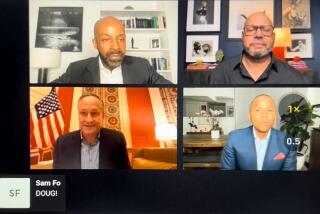Buddies an Rx for Loneliness, AIDS Misperceptions
- Share via
When Alysanne Taylor became a volunteer in the AIDS Services Foundation’s “buddy program,” she was expecting to comfort and support someone frail and sickly.
She was not prepared for what happened when she first met Robert Goehring, a 30-year-old Newport Beach resident whose AIDS was diagnosed in February of 1990.
Goehring didn’t appear at all weak--in body or spirit--when he greeted her at the door of his Newport Beach home and invited her to take a walk with him before going out to dinner. They set out just before dark during a lull in a storm on a cold, blustery March day.
With the sky threatening to burst, Taylor expected it to be a brief jaunt, but the 23-year-old Costa Mesa resident found herself struggling to keep up with Goehring during a long, brisk walk along the beach.
When it began to drizzle, Goehring kept going, drawing Taylor’s attention to the beauty of the waves rising tumultuously against a blanket of dark, foreboding clouds.
Goehring was so absorbed in his surroundings that Taylor, who was not wearing walking shoes and hadn’t brought an umbrella, was reluctant to break the spell.
“We finally turned back because I was getting tired,” she recalls.
As they headed for shelter, they got caught in a downpour that left them both drenched. And exhilarated.
“We couldn’t stop laughing,” says Taylor, who was startled by Goehring’s high energy level and lack of concern about getting cold and wet.
She was amazed that, in spite of the critical illnesses he’s had since developing AIDS, Goehring showed no sign of being tentative or cautious on a day when most healthy people would have stayed indoors.
Taylor realized as she reveled in the freedom of feeling the rain and wind on her face that Goehring had a lot to teach her about how to live. And by the end of the evening, after she and Goehring had shared hours of open, wide-ranging talk, she also knew that the person she’d been assigned to assist as a “buddy” was someone with whom she could quickly form a real friendship.
Taylor is one of 45 volunteers building friendships with people who have sought help from the Irvine-based AIDS Services Foundation, a nonprofit organization that provides emotional and practical support to clients with AIDS or symptomatic HIV infection.
The foundation serves a population of AIDS patients that will get national attention on television tonight, when CBS broadcasts “48 Hours” at 10 p.m. The hourlong program will use Orange County as a backdrop for a report on AIDS in suburban America.
Sue Bunker, director of volunteer development for the AIDS Services Foundation, says the organization was formed in 1985 by people who “were tired of seeing their friends die alone.”
“Many people lost social and family networks when they were diagnosed with AIDS,” she explains. Although there has been some improvement in the social climate over the past seven years, “we still see people without support all the time,” she adds.
Those who provide support through the buddy program receive 30 hours of training before they are matched up with someone who has AIDS. Then it’s up to each pair to determine what shape their relationship will take. Some volunteers make weekly visits and provide practical support--delivering free groceries from ASF’s food pantry and helping with errands, for example--while others get involved on a deeper level. (For information, call volunteer coordinator Cathy Winthrop at (714) 852-1010.)
“We look for people who are open, compassionate and sensitive,” Bunker notes. “They offer non-judgmental support. They don’t have that emotional piece of blame that family members might have.” Some volunteers end up filling in for family members who have withdrawn from the AIDS patient’s life. For example, one volunteer helped a man with AIDS decide who should take care of his children after his death. Another was sitting at her buddy’s bedside when he died. And another shared a close friendship for two years with a man who otherwise would have had to face AIDS alone. He died seven months ago, and the volunteer is still grieving.
Bunker says the possibility of losing a friend is discussed during training, “but nothing can prepare you for that. We don’t get used to losing people.”
The volunteers do support each other through the grieving process, however, and many draw inspiration from the buddies they have lost.
“They come away with a deeper, richer sense of quality of life. They learn a great deal about dignity, compassion and living fully,” Bunker says.
Most volunteers end up feeling that they receive more from the buddy program than they give, according to Bunker.
“At its best,” she observes, “it’s two individuals who share and grow and learn from each other.”
That aptly describes what has been happening over the past two months between Taylor and Goehring, who see each other at least once a week and have long phone conversations almost every day.
They boost each other out of low moods and share highs, talk through problems and, as often as possible, make each other laugh. Although there have been times when Goehring has been anxious about his health and Taylor has been able to offer reassurance, he says he seldom talks about AIDS because the disease doesn’t dominate his life.
That surprised Taylor because, until she met Goehring, she had been exposed only to the devastation of AIDS, which has claimed the lives of a number of the friends with whom she grew up in San Francisco. She volunteered for the buddy program after a close friend up north who has not told his family he has AIDS admitted that he has suffered more from loneliness than illness.
But Goehring has shown Taylor that not everyone with AIDS is hiding out--or waiting to die.
As of March 31, Goehring was one of 853 surviving AIDS victims in Orange County. (According to the Orange County Health Care Agency, there have been 1,220 AIDS deaths in the county since the early ‘80s.)
People with AIDS now live a median of 18 months after diagnosis; it’s been 27 months since Goehring learned he had AIDS, and he says optimistically, “I really don’t think this is what I’m going to die from. I could just as easily die in a car accident.”
He’s hopeful because he hasn’t faced any serious illness since he recovered from a nearly fatal case of salmonella in January, 1991. He feels that--with a regimen of moderate exercise, healthy eating, rest and stress-relieving meditation combined with medication such as AZT--he may be able to “hold on” until a cure is found.
He wants people to know that not everyone with AIDS fits the image of “an anorexic in a hospital bed.”
For Goehring, having AIDS has been a catalyst for so much self-discovery and inner growth that he can say: “I’m thankful that it’s made me take charge of my life.”
Goehring, who has been openly gay since he graduated from high school, says he probably was infected with the HIV during a period of one-night stands in the early ‘80s, a time when, he now realizes, he was using sex as an antidote for insecurity and low self-esteem.
In spite of his high-risk lifestyle, he resisted being tested for AIDS--even when he came down with pneumonia in November, 1989. After he recovered, he returned--”in denial”--to his high-pressure job as a production artist in an advertising agency. But persistent fatigue finally persuaded him to get tested in February, 1990. Just a week after learning he was HIV-positive, he was hospitalized with pneumonia--and forced to confront AIDS.
Goehring, who has also survived a case of meningitis that put him in the hospital for a month, says he hit his lowest point emotionally when he planned his funeral during his first illness after being diagnosed.
Having done that, he made a vow that if he survived, he would lead a healthier lifestyle, emotionally and physically.
“I knew I needed to take care of myself. No one else could do it for me,” he says.
For him, that has meant big changes. He broke up a nine-year relationship with a man who wasn’t able to give him the kind of support he felt he needed to deal with AIDS, and he left his job on disability and went back to college to pursue a boyhood dream of becoming an architect.
He also got involved in a support group for AIDS victims, started seeing a psychotherapist weekly and he participated in a photography class that gave him an artistic outlet for his feelings about AIDS.
Goehring firmly believes that his survival depends largely on his ability to face problems as they come up and not allow stress to build.
“I used to bury my feelings. I don’t do that any longer,” he says.
He also believes the stress of secrecy can be a health threat to AIDS victims.
“I’m so glad I don’t have to hide,” says Goehring, noting that being honest with others has helped him to be honest with himself.
His family in Pennsylvania has been supportive, and he says he has grown closer to his parents and two sisters since he told them he has AIDS.
“I’ve been fortunate,” he says. “I haven’t had to deal with rejection.”
To those who are afraid to come out of hiding, he says: “If you come across one person who rejects you, you’ll find another who won’t. Someone will be there for you.”
Someone like Alysanne Taylor, for example.
No matter what happens, she says, she’ll be there for Goehring, who has helped her lead a fuller, less stressful life since she shared that carefree walk in the rain with him in March.
“I talk to more people now than I ever did before because Robert has made me feel so good about dealing with problems,” she explains. “He’s taught me so much about being honest with myself.”
On the night they met, Goehring showed Taylor a handmade book that--through his own words as well as photographs--chronicles his battle with AIDS.
The book includes many self-portraits, and in most of them, Goehring is smiling. One caption that Taylor found particularly inspiring explains why: “I’ve reached the point of appreciating myself, my talents and the good person I am. I’m being--I am happy! All I want from me is what I am.”
Goehring ends the book with this hopeful pronouncement: “And life goes on! And on, and on!”
More to Read
Sign up for Essential California
The most important California stories and recommendations in your inbox every morning.
You may occasionally receive promotional content from the Los Angeles Times.










